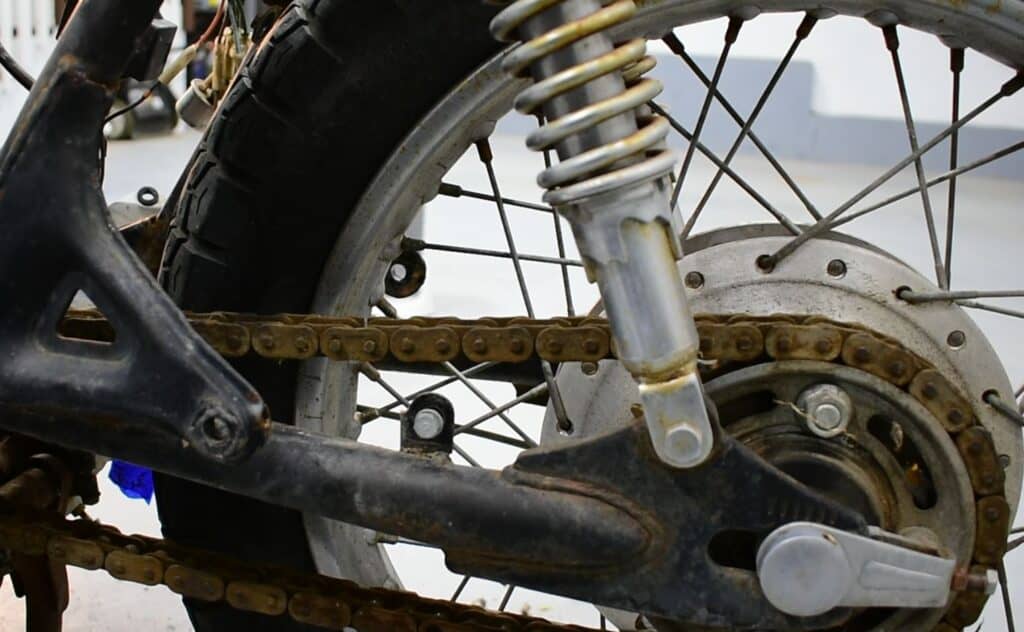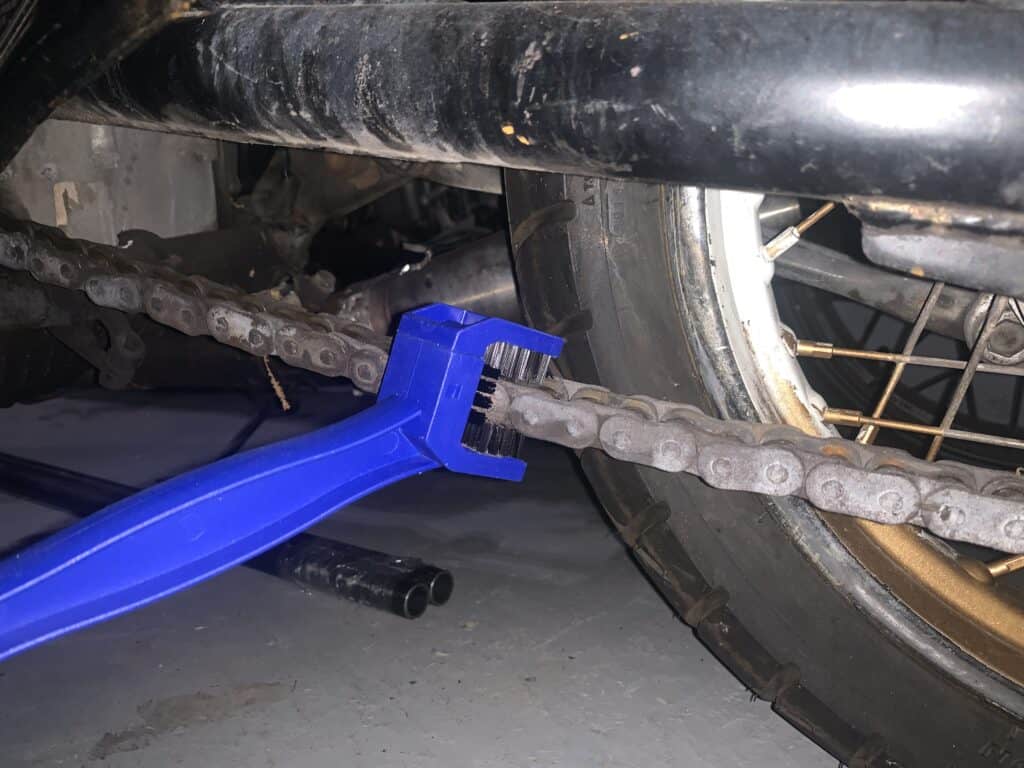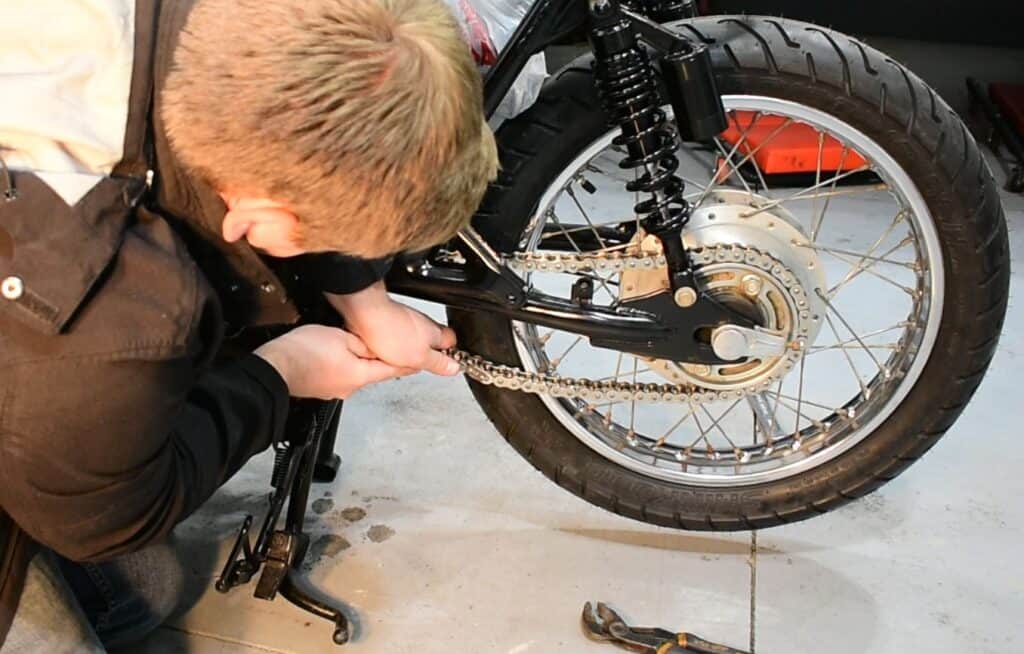
There are several ways a motorcycle receives power from the engine. That power can either come from a chain, a belt, or a shaft. Chain driven motorcycles are by far the most common type of drivetrain found on the roads today.
Motorcycle chains are simple mechanisms and require simple maintenance, but because they are so vital to the function of the motorcycle they require prompt attention when anything unusual happens to them, like rust.
Why is my motorcycle chain rusting? A motorcycle chain rusts because the metal has been exposed to a combination of moisture and oxygen. This can be caused by a lack of maintenance and riding the motorcycle in rough conditions such as wet, salted roads.
Making sure the chain is working correctly is an important part of maintaining proper motorcycle functionality. Though it’s a simple mechanism, a chain malfunctioning can cause some catastrophic consequences. Here’s what you need to know about rusty chains, how to prevent it from happening, and what to do if it does happen
The Reasons Why A Motorcycle Chain Gets Rusty
The concept of rust is no stranger to most motorcycle owners, especially if you own an older bike. A few rust spots here or there is usually nothing to worry too much about. But it can be, and should be, worrisome if you find rust on the chain of your motorcycle.
If you do notice any rust forming on your motorcycle chain, you’ll need to promptly address it before it ends up getting worse and causes you major problems down the road. First, it’s ideal to understand why it’s happening in the first place so you can alter your maintenance routine to prevent it from happening again.
Rust, or iron oxide, forms when the iron or steal is exposed to moisture and oxygen. These metals don’t just spontaneously start to rust, moisture has to be added to the picture for it even to begin. There is some moisture in the air we breathe, so that in itself can start the oxidation process. Your motorcycle chain is especially susceptible to rust if you live in humid areas.
The main reason rust begins to start it’s oxidation process is because of lack of maintenance. That’s not to say that because rust forms on your chain you’re bad at maintaining your motorcycle. As I mentioned before, some environments call for more frequent attention to the chain than others, so just be aware of what your climate calls for.
Chain maintenance includes lubing and cleaning the chain several times a year. The lubrication that’s applied to the chain is not soluble with water, so it will repel any possible moisture that could build up on the chain. Regular usage of the chain does wear out the lubrication so routine maintenance is a must.
Other factors could speed up the oxidation process such as riding on wet roads that have been salted. Salt is an element that contributes to rusting, so even if you regularly maintain your motorcycle chain, the salt your drive through can still cause rusting to occur.
A motorcycle chain should be lubricated and it’s tension checked every 4,000 miles or every six months, whichever comes first.
Can You Clean/Remove The Rust On A Motorcycle Chain?

If you’ve found some rust forming on your motorcycle chain, you may be wondering if it’s possible to remove the rust and still be safe riding your motorcycle on the roads. A lot of this depends on the severity of the rust and how far in the process it has gotten.
You may only be looking at surface rust. This type of rust is the very beginning of the metal’s oxidation process and if caught soon enough, it can easily be removed with no harm done to the chain.
So, yes, it is possible to remove rust if it has not yet begun to start pitting through the metal of the chain. An easy way to tell how far the rust has gone is by simply cleaning the rust off with your finger or a wet rag. If it comes off easily with no signs of wear underneath, you can begin the process of thoroughly cleaning the rest of your chain.
You’ll need to get a cleaner specifically for motorcycle chains, a soft bristle brush such as a toothbrush or a nylon brush, a rag, and some chain lubrication. Make sure your motorcycle is turned off anytime you clean and lubricate the chain on your motorcycle.
You’ll need to get the motorcycle into a position where you can easily rotate the back of the tire. This means you’ll need to raise the back of the motorcycle with a lift or use the center stand. First, spray a generous amount of chain cleaner on the chain while rotating the back of the tire. You’ll likely get a nice little puddle underneath the tire, so make sure you work in a place where it’s okay to do that.
Once the chain is soaked in the cleaner, you’ll want to use a soft bristle brush (not a wire brush) and scrub all sides of the chain. This will ensure you’ve gotten all of that surface rust off. Wipe the entire chain with the rag to get as much of the cleaner off as you can. Inspect the chain for any rust you may have missed.
Once the cleaner is wiped off, you can now apply the chain lubrication to the chain. Apply a generous amount on all side of the chain and lightly wipe away any drips that are coming off of it. Again, inspect the chain to ensure the rust is gone and that the surface rust did not start pitting anywhere.
If you’ve ensured that all the rust is gone and no damage has been caused by it, you are free to continue using the chain and ride your motorcycle worry-free.
At What Point Should I Replace The Chain?

There is a point where rust can cause too much damage to a motorcycle chain and you will need to replace the chain altogether. If the rusting process has gone further than the surface rust and has begun pitting the metal, meaning it has started eating away any of the smallest parts of the chain, you will need a new one.
Sometimes when a chain breaks during a ride, the chain will simply slide off and you lose power. That may sound like it’s not so bad until you picture yourself in the middle of the freeway with a sudden loss of power.
There’s also the possibility of the chain getting flung behind you at a high speed and hitting and/or damaging vehicles that are behind or around you. Because a broken chain means a loose and flexible piece of metal, there’s no predicting where it will go which means it could fling up and wack the back of your leg. Chains have been known to cause some serious leg injuries to motorcyclists.
The chain also has the potential to wad up on the sprocket and jam it altogether. This could cause an instant brake on the back tire and throw you off balance during a ride. For more information about what happens when a motorcycle chain breaks, see my other article by clicking here.
If there is any second guessing yourself or any slight worry that rust has done a little too much damage to your motorcycle chain, you need to just replace it. There’s no reason to risk the possible outcomes when the preventative solution is simple and cheap. A new motorcycle chain is only about $30-$60 if you know how to replace it yourself. Having a shop replace it for you is about $150.
Conclusion
Don’t get too down on yourself if you have found a rusty chain on your motorcycle, it happens to most motorcyclists. Rusty chains happen because of the reaction between moisture and oxygen. Additionally, motorcycle chains rust because they need more maintenance performed.
If you think your chain has been compromised because of rust, I would highly suggest that you just replace it. I’ve replaced dozens of motorcycle chains since I flip motorcycles and it’s always a good feeling when I do it knowing I’ll be safer (and so will the future buyer). Please feel free to reach out with any questions you have about your motorcycle chain, I’m always happy to help!
